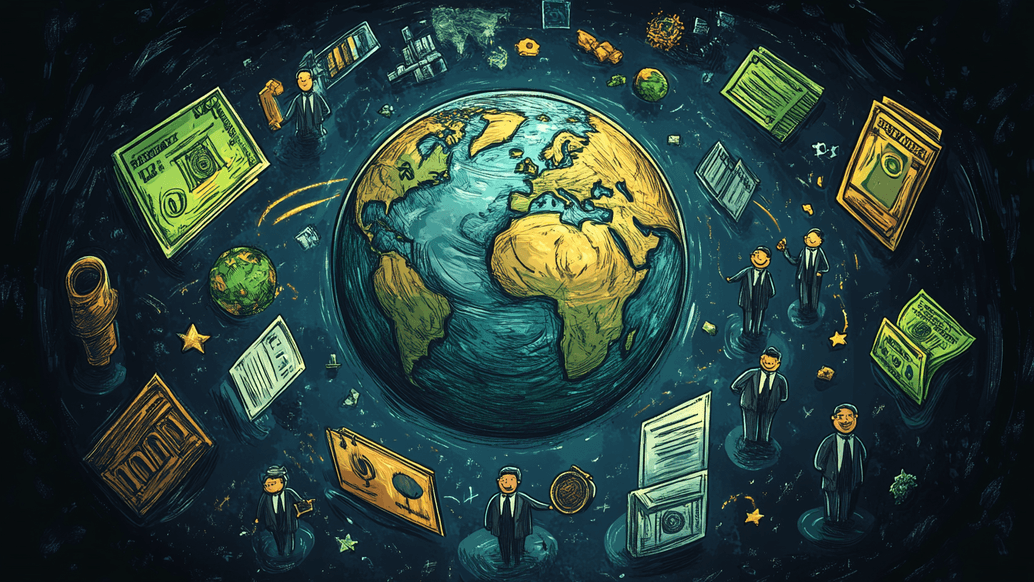International Finance: Key Concepts and Global Impact
Contents

International finance. This notion pops up everywhere: in the news, financial overviews, educational courses, article titles, and more. Yet, do you really know the international finance meaning, how it impacts the global economic system, and how it impacts other global processes? Let’s explore what stands behind this broad concept together.
Understanding International Finance

What is international finance? Also known as international macroeconomics, it’s a vital area of economics that focuses on the monetary connections and interactions between two or more countries. It encompasses a wide range of activities, including foreign exchange, international investment, and the study of global financial markets. The basics of international finance rest on a few key concepts.
Foreign Exchange Markets
Forex embraces international decentralized or over-the-counter markets for trading currencies. It determines the foreign exchange rate for every currency and covers all aspects of buying, selling, and exchanging currencies at current or determined prices. The main participants in forex markets are central banks, commercial banks, investment banks, corporations, hedge funds, and individual traders.
International Capital Markets
They regulate the channeling of savings and investments between investors and borrowers across national borders. These markets facilitate the flow of capital from one country to another using a range of instruments, such as stocks, bonds, Eurobonds, foreign bonds, and various derivatives like options and futures. Major players in this scene are governments, multinational corporations, institutional investors, and individual investors.
Investment Analysis and Risk Management
These are two crucial areas of international finance primarily focused on evaluating the potential of investments and mitigating all types of financial risks. At the core of investment analysis is the study and estimation of the investment asset’s intrinsic value and future price movements by examining related economic, financial, and other qualitative, quantitative, and historical factors.
Risk management relies on such techniques as hedging, investment diversification, and insurance to protect against possible financial, political, and credit risks and offset potential losses.
Regulatory Environments
This involves the laws, regulations, and institutions that govern financial transactions across borders to ensure the stability, transparency, and integrity of the global financial system.
Importance of International Finance

At this point, the international finance definition is quite clear. The next aspect to look at is why it is so important and its far-reaching implications. The more interconnected the world’s economy becomes, the higher the importance of international finance, which is seen in several major aspects.
International Trade Maintenance
International finance is the lifeblood of global trade's smooth operation, providing mechanisms for currency conversion and financial transactions across borders and ensuring that exporters get paid and importers receive their goods.
Economic Growth Promotion
By giving access to foreign capital and linking national financial markets, international macroeconomics enables investment in infrastructure, technology, and other productive assets. As a result, it fosters economic development and job creation while ensuring additional capital and liquidity to domestic markets.
Encouraging Innovation
Foreign investments bring new technologies, advanced expertise, and business practices, enhancing productivity and competitiveness. Exposure to global markets forces domestic firms to improve efficiency and quality to compete internationally.
Financial Stability
International finance contributes to the global economy’s ability to withstand shocks and maintain steady growth through efficient monetary cooperation, consistently effective risk management, smart investment diversification, and effective financial crisis prevention.
Globalization
Global macroeconomics is a key driver of globalization, facilitating cross-border trade, investment, and economic integration. It maintains capital mobility, trade expansion, and cultural exchange for more efficient resource allocation, valuable expertise exchange, economic cooperation stimulation, and active spread of ideas and technologies.
Examples of International Financial Institutions

International finance operations and activities are standardized, regulated, managed, and controlled by a bunch of international institutions. This approach was set in 1944 by the Bretton Wood Conference, in which 40 countries established a fixed exchange rate system to unify international monetary policy and give rise to the development of different global organizations with specific interests in cross-border monetary interactions. The key institutions that define international finance today include:
- International Monetary Fund (IMF) provides financial assistance and policy advice to member countries facing economic instability.
- World Bank supports projects in developing countries, promoting economic progress and reducing poverty.
- Bank for International Settlements (BIS) facilitates cooperation among central banks and ensures global financial stability.
- Regional Development Banks provide financial and technical assistance to countries within specific regions, focusing on local economic development and integration.




